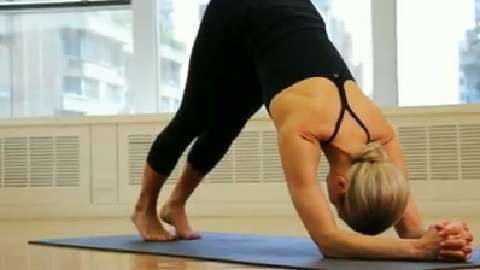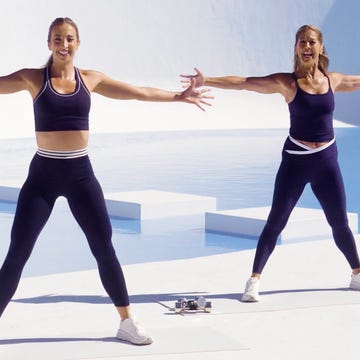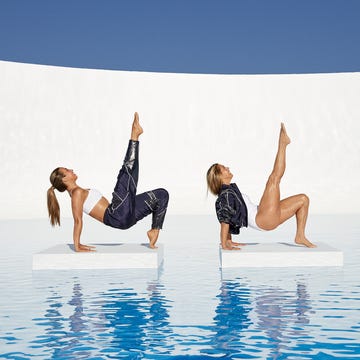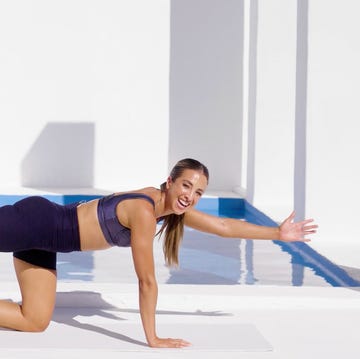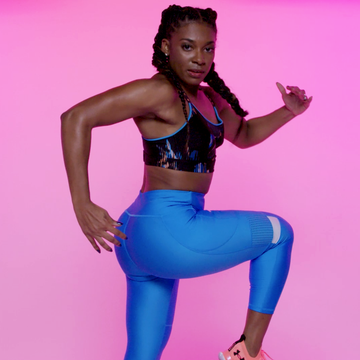You put a lot of thought into your diet and workout routine, but your rest and recovery days are just as important. You may not be pounding the pavement or crushing it at the gym, but there are a few strategic things you should be doing to help your body stay in tip-top shape. Below, experts share their best tips for helping you make the most of your R & R days.
While sitting on the couch can be super enticing (hello, Netflix!), there's a lot your body needs on a rest day that can't be solved by sitting still. Muscle stiffness, metabolic waste (i.e. acid build-up in the body), delayed onset muscle soreness, and hydration are all factors to think about, says Luke Greenberg, a physical therapist at MOTIVNY.
"Just sitting on the couch alone is going to tackle only your dehydration," he says. Therefore, it's key to get in active recovery workouts that will increase circulation on your day off from your usual regimen. This movement will get blood flow and oxygen to the parts of your body that need it, which will in turn help alleviate all the tightness you feel from stiffness and lactic-acid buildup in your muscles.
"Try doing some light exercise for 20 to 30 minutes such as swimming, low-intensity cycling, gentle yoga, or other bodyweight movement practices. Think difficulty six or less out of 10," he says.
Try this yoga sequence to fend off injury, improve flexibility, and build strength:
Your rest day is a great opportunity to give yourself a sports massage, Mark Goodman, National Academy of Sports Medicine-certified trainer and founder of Cardio High Fitness, says.
Greenberg suggests targeting areas that are tight from running and sitting, which typically require some love on all days, but on rest days specifically.
"I'd pick the upper glutes, piriformis (where you feel a pigeon stretch), and upper thoracic spine between the shoulder blades," he says. But don't just lie on the spots that are sore. Instead, use a foam roller or lacrosse ball to put pressure on the areas for about 10 seconds then move the roller or ball around or mobilize the muscle. "Don't expect change from hanging out and watching HBO while draped over the foam roller with a glass of rosé."
Related: 7 Reasons Your Butt Isn't Changing No Matter How Much You Work Out
Keep in mind that rest days don't equate to major cheat-meal days if you're working toward a fitness or weight-loss goal. In fact, nutritionist Keri Glassman, R.D., recommends eating similarly on your days off as you would on a regular day, but perhaps a little less.
"Often times working out can increase your hunger, so if on your rest days you're not feeling quite as hungry, or you're not having a hankering for an afternoon sweet, listen to your body," she says. "But, you should be eating to fuel your muscles all the time—recovering or on workout days."
There's some research that suggests eating blueberries, tart cherries, and other dark-colored fruits will help offset delayed onset muscle soreness (DOMS), says Boston-based trainer and B/Spoke cycling instructor, Katie Dolaher.
Leafy greens and cruciferous vegetables (broccoli, Brussels sprouts, cauliflower) will also improve your metabolic processes, keep you hydrated, and reduce inflammation, according to Dolaher.
Glassman agrees that hydration is key. "It contributes to so many cellular processes in the body, everything, from metabolism to your digestion." (Learn how bone broth can help you lose weight with Women's Health's Bone Broth Diet.)
Not only is this a great stress-reliever, but an Epsom salt bath is a completely relaxing way to soothe your sore, screaming muscles, thanks to its combination of magnesium and sulfate, Dolaher says. Bonus points go to the magnesium, which has been proven by research to lower cortisol, the hormone you can thank for all of your pent-up stress. Plus, there's some colloquial evidence that Epsom salt baths can help reduce bloating.
Baths have earned a lot of attention for their health benefits. Specifically, one study published in the journal Temperature revealed that taking a hot bath can burn about 140 calories an hour, also lowering blood sugar by about 10 percent more than exercise. The research is still pretty fresh (plus, they only studied 14 men), so don't sub your workout for a bath, but do enjoy one on your recovery days to relax, unwind, and soak up (literally) the benefits.
Related: The Best Way to De-Stress, According to Your Zodiac Sign
If you're a little over that foam roller or lacrosse ball, treat yourself to a massage, which will allow your and your muscles to chill the hell out. Wil Lewis, the massage program director for Chillhouse in New York City, says that a massage on a rest day is the perfect time to physically sort out muscles that have been hard at work at the gym or hunched over a desk at work. But there's also a neurological benefit of massage.
"Massage affects your nervous system in that it puts you in a mode to let your body heal and rest, ridding itself of metabolic waste," he says. "It does depend on your schedule and income, but a regular massage, whether weekly or monthly, can help someone target their fitness goals."
In order to make the most of your massage, Lewis suggests picking a goal for the massage the same way you'd pick a goal for the workout.
Make sure you know what you want to get out of it and communicate that clearly to your therapist by telling her you're looking for stress release, relaxation, intense muscular release, or stretching.
"If you're paying upward of $100 for a 60 minute massage that means every minute should be worth $2 so it needs to be worth it."

